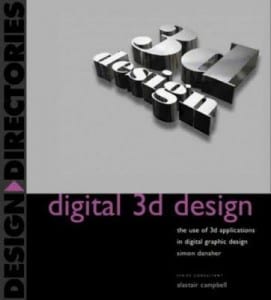3D design will be a critical part to my advertising for my products, this book explains in great detail the core concepts of 3D design that will be benefit me when creating my 3D animations, enabling me to advertise my products.
Within the book I will be specifically looking at Chapters:
- Core Concepts (Page 30-93)
Core Concepts
In this chapter, the core concepts of creating any 3D object are discussed, however the main concepts relevant to my project are listed below:
1) Modelling – In 3D design, most objects that are used within an animation or piece of 3D design are often modelled from scratch in two ways. Point by point modelling is one way were individual points or polygons are moved by hand to create the object desired and primitive modelling is another form were the use of simple shapes are created and merged together to make more complex objects. The latter type of modelling can be used within the 3D advertising section of my project as I will be able to use simple shapes to create fairly complex objects easily, this will greatly reduce the time needed to create all of the objects allowing me to focus on other aspects of my project.
2) Resolution – Resolution is terms of 3D design relates to the amount of polygons that are used within an object to make it smooth, the higher the count the smoother the object will be and this is the same for the opposite. When rendering it is essential that the amount of polygons used within the objects are at the optimum point as too little will make the object look rough in terms of its surface clarity and too many will slow the system down as each point will have to be computed by the RAM, leaving less for the program to operate.
3) Bezier, Splines and Surfaces – Bezier curves in this sub-section is covered in relation to object creation/modelling, these operate in the same way as they do in 2D programs such as Illustrator & Photoshop, once an anchor point has been created there is a tangent handle that allows for the user to alter the curve, this is turn will change overall shape of the object in 3D space.
4) NURBS & Sub-division Surface – NURBS or Non-Uniform Rational B-Spline is a special type of spline that allows for jagged lines to smoothed out, differing from normal splines. When made a child of NURBS, the overall smoothness of the line in controlled by degrees, meaning that the higher the degree value, the smoother the overall line shall be. This relates similarly to the resolution, as the number of the NURBS increases the overall smoothness does too and this is the same for the opposite.
5) Shading, Illumination and Specularity – Once the modelling and animating of the objects has been finalised, the last job to do is the texture painting of the objects to fully bring it to life. Shading, illumination and specularity are three key components that are emphasised in great detail that help to increase the realism of the product. It is stated that there are 3 parts to illumination – Specular, Diffuse and Ambient. Specular is the ‘hot-spot’ that you can see on shiny objects, this is often a direct reflection of the illumination source and help to determine to the user what type of material the objet is made from. Diffuse is the way in which the material diffuses the light illuminating it – this will often eliminate the specular highlight on the object and will turn it into a large broad section where the object is lit up. Ambient is the way in which the environment reflects the light being illuminated by the source object – high ambient illumination will often cause shadows of objects to be less apparent as the environment is reflecting more light onto the opposite side of the object.
Danaher, S. (2001) Digital 3-D Design. New York: Cengage Learning PTR.

Leave a comment